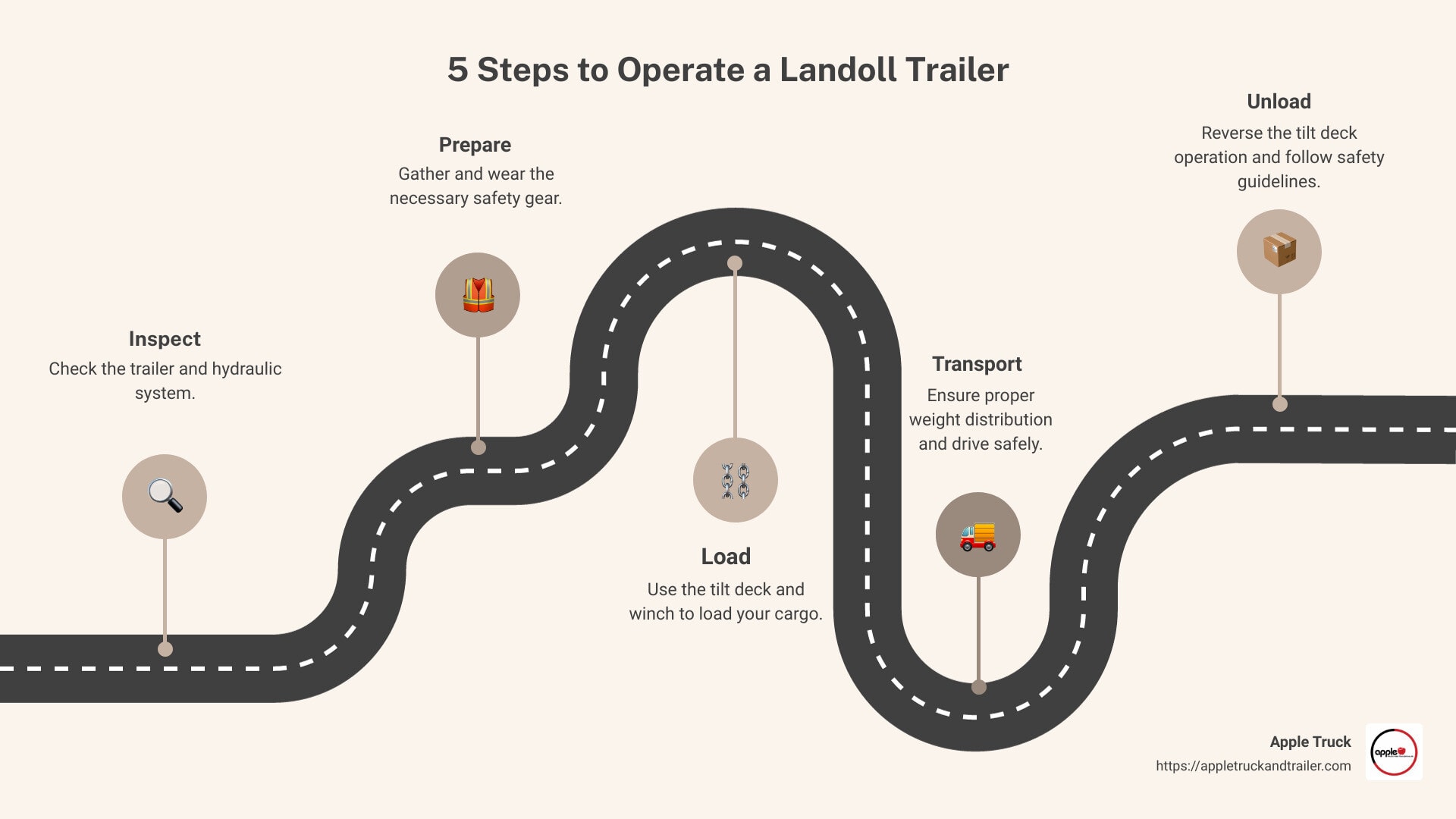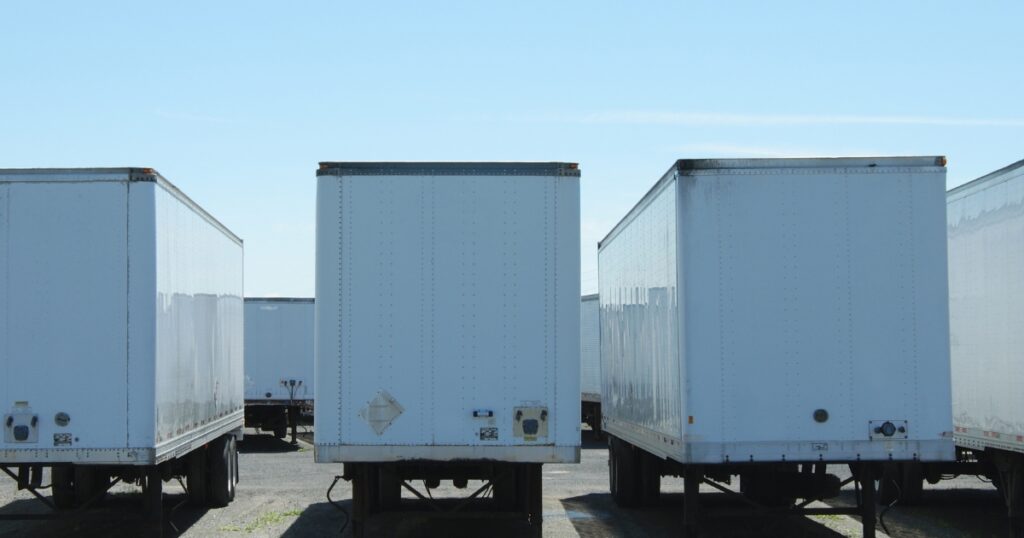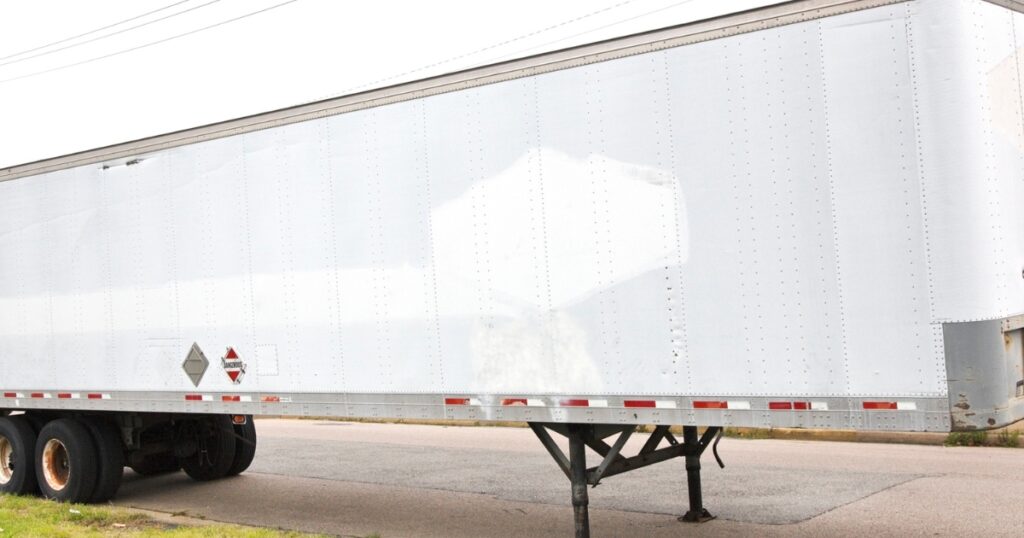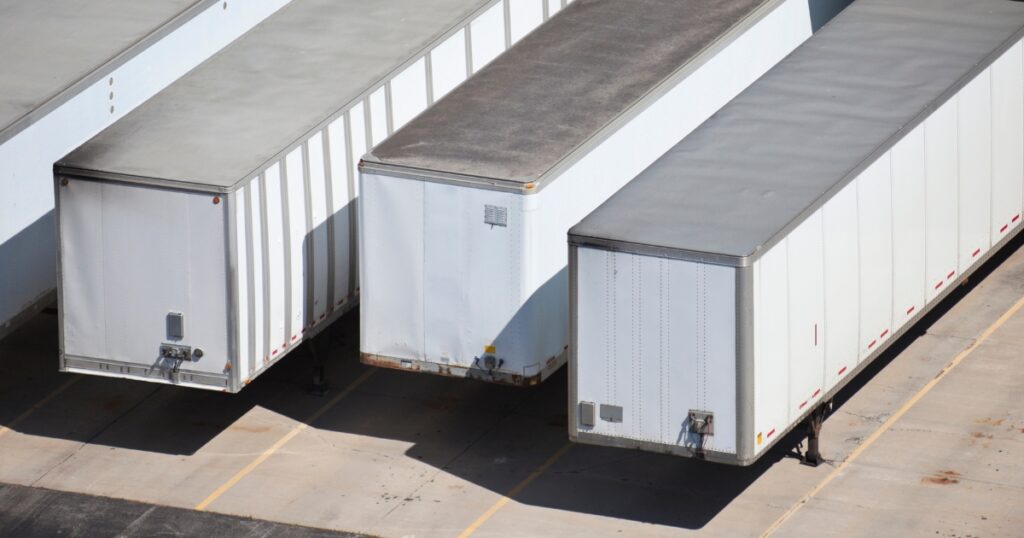If you’re here to learn how to operate a Landoll trailer, you’re in the right place. These step-by-step instructions, including how to use the hydraulic tilt deck, will make sure you’re well-prepared! Discover how to operate a Landoll trailer with expert guidance from Michael Sensano, Sales Manager at Apple Truck and Trailer. Learn step-by-step instructions for using the hydraulic tilt deck and more.
Quick Steps to Operate a Landoll Trailer:
- Inspect the trailer and hydraulic system.
- Prepare safety gear.
- Load using the tilt deck and winch.
- Consider using the chain drive load system as an alternative method for loading heavy equipment.
- Transport with proper weight distribution.
- Unload with safety in mind.
Landoll trailers, especially the versatile 400 series, are an essential tool in the trucking industry. Whether you’re transporting heavy machinery, construction equipment, or even non-running vehicles, understanding how to operate these advanced trailers is crucial for efficiency and safety. This guide will walk you through every step of the process, ensuring you make the most out of your Landoll trailer.
I’m Michael Sensano, Sales Manager at Apple Truck and Trailer. With years of hands-on experience, I have helped countless clients navigate the complexities of operating Landoll trailers. Let’s dive right in!

Table of Contents
Understanding the Landoll 400 Series
The Landoll 400 Series trailers are known for their versatility and ease of use. One of the standout features is the hydraulic tilt deck, which enhances loading and unloading efficiency.
Designed to handle a variety of loads, these trailers are perfect for transporting heavy machinery, construction equipment, and even non-running vehicles.
The Landoll 400 Series is also suitable for transporting modular homes.
Below, we’ll break down the key features, specifications, hydraulic systems, and axle configurations that make the Landoll 400 Series stand out.
3 Key Features of the Landoll 400 Series
- Tilt Deck Operation: One of the standout features of the Landoll 400 Series is its tilt deck. This feature allows the deck to tilt to the ground, making it easier to load and unload heavy equipment without the need for additional ramps.
- Hydraulic Systems: The hydraulic system is the heart of the Landoll 400 Series. It controls the tilt deck and the traveling axle, ensuring smooth and efficient operation. The hydraulics are powerful enough to handle heavy loads and offer precise control during loading and unloading.
- Winch Options: Many Landoll 400 Series trailers come equipped with winches, making it easier to load non-running vehicles or heavy equipment. The winch system is designed for fast chaining, reducing the time and effort required to secure loads.
A chain drive load system is also available, providing an alternative method for handling heavy loads efficiently.
Specifications
The Landoll 400 Series trailers come in various models, each with its own specifications. Here are some common specs you might find:
- Length: Typically around 53 feet, providing ample space for large equipment.
- Weight Capacity: Depending on the model, these trailers can handle loads ranging from 50,000 to 100,000 lbs.
- Deck Height: The low deck height is ideal for transporting tall loads, keeping them within legal height limits.
Hydraulic Systems
The hydraulic system in a Landoll 400 Series trailer is crucial for its operation. It powers the tilt deck and the traveling axle, allowing for smooth and controlled movements. Here’s how it works:
- Tilt Deck: When activated, the hydraulics lower the deck to the ground. This makes it easy to drive or winch equipment onto the trailer.
- Traveling Axle: The axle moves forward and backward along the trailer. This feature is particularly useful for adjusting the weight distribution of the load.
Axle Configuration
The axle configuration of the Landoll 400 Series is designed to offer maximum stability and weight distribution. Here’s a closer look:
- Sub Frame Mounted Axles: The axles are mounted on a sub-frame that moves forward and backward. This configuration helps in distributing the weight evenly across the trailer.
- Air Ride Suspension: The air ride suspension ensures a smooth ride, reducing the impact on the load and the trailer itself. When loading, the air ride can be dropped to lower the deck further.
How to Operate a Landoll Trailer

Operating a Landoll trailer, especially the 400 Series, involves several steps to ensure safety and efficiency. Here’s a comprehensive guide on how to operate a Landoll trailer.
Preparing the Trailer
- Inspection: Before you start, inspect the trailer thoroughly. Check for any visible damage or wear on the tires, brakes, and lights. Ensure all safety pins and locks are in place.
- Hydraulic System Check: Verify the hydraulic system is fully operational. Look for leaks and ensure the fluid levels are adequate. Test the hydraulic controls to make sure they respond correctly.
- Safety Gear: Equip yourself with the necessary safety gear, including gloves, safety glasses, and steel-toed boots. Have warning signs and cones ready to alert others of your operation area.
Loading the Trailer
- Tilt Deck Operation: Engage the hydraulic system to tilt the deck. Lower the air ride suspension and tilt the deck to the ground. This step is crucial for loading equipment smoothly.
- Winch Usage: If loading non-running equipment, use the trailer’s winch. Attach the winch cable to the equipment and slowly pull it onto the deck. Ensure the equipment is centered to maintain balance.
- Securing the Load: Once the equipment is on the trailer, secure it with chains and binders. Make sure all tie-down points are used and the load is stable. This prevents shifting during transport.
Transporting the Load
- Weight Distribution: Distribute the weight evenly across the trailer. Follow the 60/40 axle rule, where 60% of the weight is in front of the rear axle and 40% behind. This ensures optimal balance and reduces strain on the trailer.
- Driving Tips: Drive cautiously, especially when carrying heavy or oversized loads. Avoid sudden stops and sharp turns. Monitor your speed and maintain a safe distance from other vehicles.
Unloading the Trailer
- Reverse Tilt Operation: Engage the hydraulic system again to tilt the deck. Lower the air ride suspension and tilt the deck to the ground. This makes it easier to unload the equipment.
- Unloading Safety: Ensure the area around the trailer is clear. Use the winch to control the descent of non-running equipment. For running equipment, drive it off the trailer slowly and carefully.
- Post-Operation Checks: After unloading, inspect the trailer for any damage. Check the hydraulic system and fluid levels again. Ensure all safety pins and locks are back in place.
By following these steps, you’ll be well-prepared to operate a Landoll trailer efficiently and safely. Next, we’ll explore common uses for Landoll trailers to give you a better understanding of their versatility.
Common Uses for Landoll Trailers

Landoll trailers are incredibly versatile and can be used for a variety of applications. Landoll trailers are also ideal for transporting modular homes, providing a reliable solution for moving these prefabricated structures efficiently. Here are some of the most common uses:
- Construction Equipment: Landoll trailers are favored in the construction industry for hauling heavy machinery like dozers, loaders, and excavators. With capacities ranging from 50,000 lbs to 100,000 lbs, they can transport almost any piece of construction equipment.
- Farm Equipment: Farmers use Landoll trailers to transport tractors, plows, and other large agricultural machinery. The Landoll 440B series, with its 53 ft length, can accommodate large combines and other oversized farm equipment.
- Non-Running Equipment Recovery: Landoll trailers excel in recovering non-running equipment such as broken-down buses, stalled dump trucks, and non-operational excavators.
Conclusion
Operating a Landoll trailer, especially from the 400 series, can be a game-changer for your transport needs. From its versatile hydraulic systems to powerful winches, this trailer is designed to handle a variety of heavy and non-operational equipment efficiently.
Summary: In this guide, we covered the essential steps on how to operate a Landoll trailer. We discussed the importance of preparing the trailer, including inspection and safety checks. We also explained how to load and secure your cargo using the tilt deck and winch. Transporting the load with proper weight distribution and unloading safely were also key points.
Contact us today at Apple Truck & Trailer. We are your go-to experts for all things related to Landoll trailers. Whether you need a new trailer, parts, or service, we have you covered. Our team is committed to providing you with the best customer service and high-quality products to meet your needs.
Learn more about our Landoll trailer offerings here.
Frequently Asked Questions about Operating a Landoll Trailer

How much weight can a Landoll trailer carry?
The weight capacity of a Landoll trailer can vary depending on the model. For instance, the Landoll 440 series 53 ft trailer has a capacity of up to 55,000 lbs. Key factors that contribute to this capacity include:
- Frame Strength: The robust construction of the trailer frame ensures it can handle heavy loads without compromising safety.
- Deck Rating: The deck is designed to support significant weight, making it suitable for transporting large and heavy machinery.
- Axle Configuration: The axles are strategically placed to distribute weight evenly, adhering to the 60/40 axle rule for optimal balance during transport.
Do Landoll trailers have winches?
Yes, Landoll trailers are equipped with winches, which are essential for loading and unloading heavy and non-running equipment. Here are some details:
- Winch Options: Most Landoll trailers come with powerful winches that can pull non-operational equipment onto the deck. This feature is particularly useful for recovery operations.
- Chain Drive Load System: Some models include a chain drive load system, which offers additional pulling power and control.
- Handling Package: The handling package often includes multiple winch options, allowing for customization based on the type of load being transported.
These features make Landoll trailers exceptionally versatile, capable of handling a wide range of transport needs efficiently and safely.
OUR CONTENT
All the information you find on our website is thoroughly researched and verified by our team of truck and trailer specialists, who bring over 40 years of experience to Auburn, Massachusetts, and the surrounding areas. At Apple Truck and Trailer, we’re all about great service and quality trailers. Ours aren’t just trailers; they’re custom solutions for your transport needs. We understand how important reliability is for your business, and we’re here to help every step. Check out our Landoll trailers, long haul transport, semi trailer trucks, semi truck leases and secure storage containers for an upgrade with expert support. We’re dedicated to providing content that’s not only accurate but also meaningful and useful for our readers.

